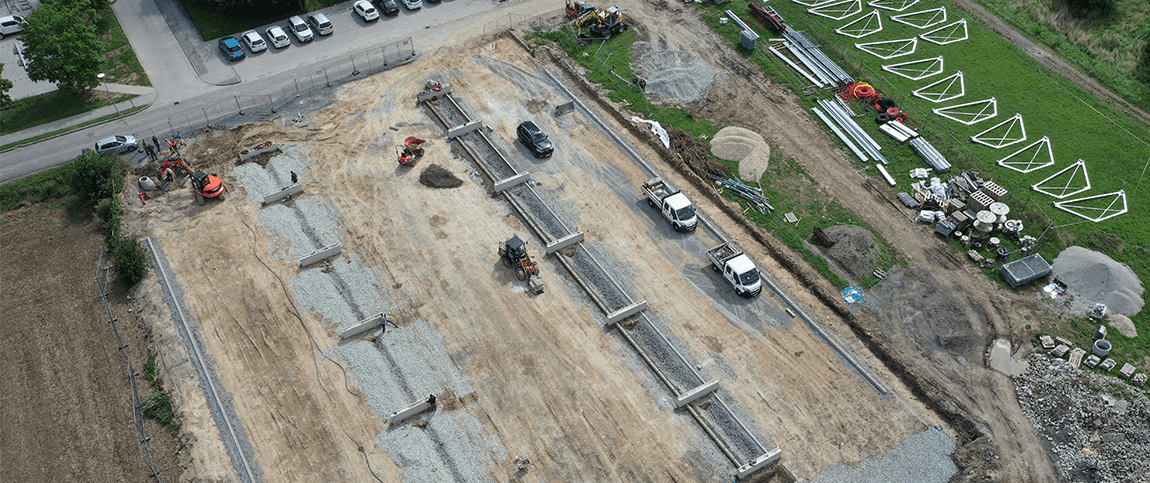Carports are typically carports made of steel, aluminum, wood or a combination of these materials that are built on outdoor areas. In domestic use, this can be the yard or garden of a family home, for professional use it is most often the car park of hotels, production or logistics halls, shopping centres or large car parks at motorways, airports, sports stadiums and so on. Carports have recently been built mainly as so-called solar carports. This means that photovoltaic panels are laid on the roof of the carport, and the whole system hides the additional infrastructure needed to generate green electricity from solar energy.

Solar carports in practice
01.03.2023
We see a steadily growing interest in solar carports from customers in a wide range of sectors. The most frequent customers are those with parking areas where, for technical or economic reasons, it is not possible to simply offer a rooftop installation of solar panels. At one end of the spectrum, for example, there may be a private bakery or hotel looking for a solution for 30 parking spaces, while at the other end there may be a global supplier of components to the automotive industry.

The use of these free areas, which were previously used only for parking, thus takes on a whole new dimension. In addition to generating the necessary renewable energy, the carport also provides parked vehicles and their users with protection from the elements, be it rain, hail or sunlight, which can make the interior of a car very hot. In winter, every driver will appreciate not having to laboriously scrape frozen windows under the shelter.
Our installation teams have quite extensive experience in installing carports or similar structures from a number of European countries. To name just two examples, we have carried out a very interesting installation for our French customer on a high-rise building in Brussels, and another installation of which we at GreenBuddies are suitably proud is the largest project of its kind in Austria, in the state of Burgenland.
When we talk about carports, it is important to remember that this is a building in the true sense of the word, which naturally also places high demands on the safety and stability of the structures. The actual implementation is therefore preceded by a series of preparatory technical tasks, which our company provides: from the basic design of the carport, through calculations and the preparation of a structural study based on the geographical location of the site and the associated amount of rain and snowfall, the size of the structure, the roof pitch, etc.

A separate chapter is the technological solution of anchoring the above-ground structure to the ground. The starting point is to carry out a geological study of the subsoil, including pull-out tests at the construction site. According to the results of this study, the designers will determine the optimal method for the foundations of the structures and their anchoring. That these are not trivial issues is demonstrated by another example from our implementation in Lutzmannsburg, where the above-ground structure sits on massive concrete blocks that we set on steel pylons extending 6 metres below ground. Of course, the technical solution is not always this demanding; in many cases, the structure is attached with bolts or on footings with smaller concrete foundations.
Although the use of shelters is primarily aimed at generating electricity from photovoltaic panels, with the development of electromobility, more and more investors are interested in the possibility of installing charging stations. This, of course, makes sense wherever an EV driver intends to park his or her car for at least an hour or more. In public spaces, there are often multiple chargers, which often optimise the system of drawing electricity from photovoltaics or the public grid by means of a so-called dynamic power management system. This system allocates the appropriate charging power according to the technical condition or degree of charge of the individual clients' batteries, or according to other parameters programmed at the operator's request. Carport manufacturers are also responding to this trend by coming up with elegant solutions for integrating chargers into the columns of overhead structures, etc.
In the last year, we have seen a noticeable increase in interest in carports among both investors and providers of complete solutions for photovoltaics and electromobility. Enquiries are pouring in from home and abroad. In addition to the above-mentioned logic of multiple use of available space, legislation aimed at promoting the construction of photovoltaic installations and the development of electromobility is also newly applied. For example, in selected German federal states, standards are being drafted (or are already in the final stages of the legislative process) requiring shopping centre parking areas above a certain size to be equipped with solar carports. The German example will surely soon be followed by other EU Member States.

Blog
Every month in the Newsletter we bring you tips and interesting facts about photovoltaics and charging infrastructure in general. You will find out news about our projects, collaborations, as well as the internal life of Greenbuddies.